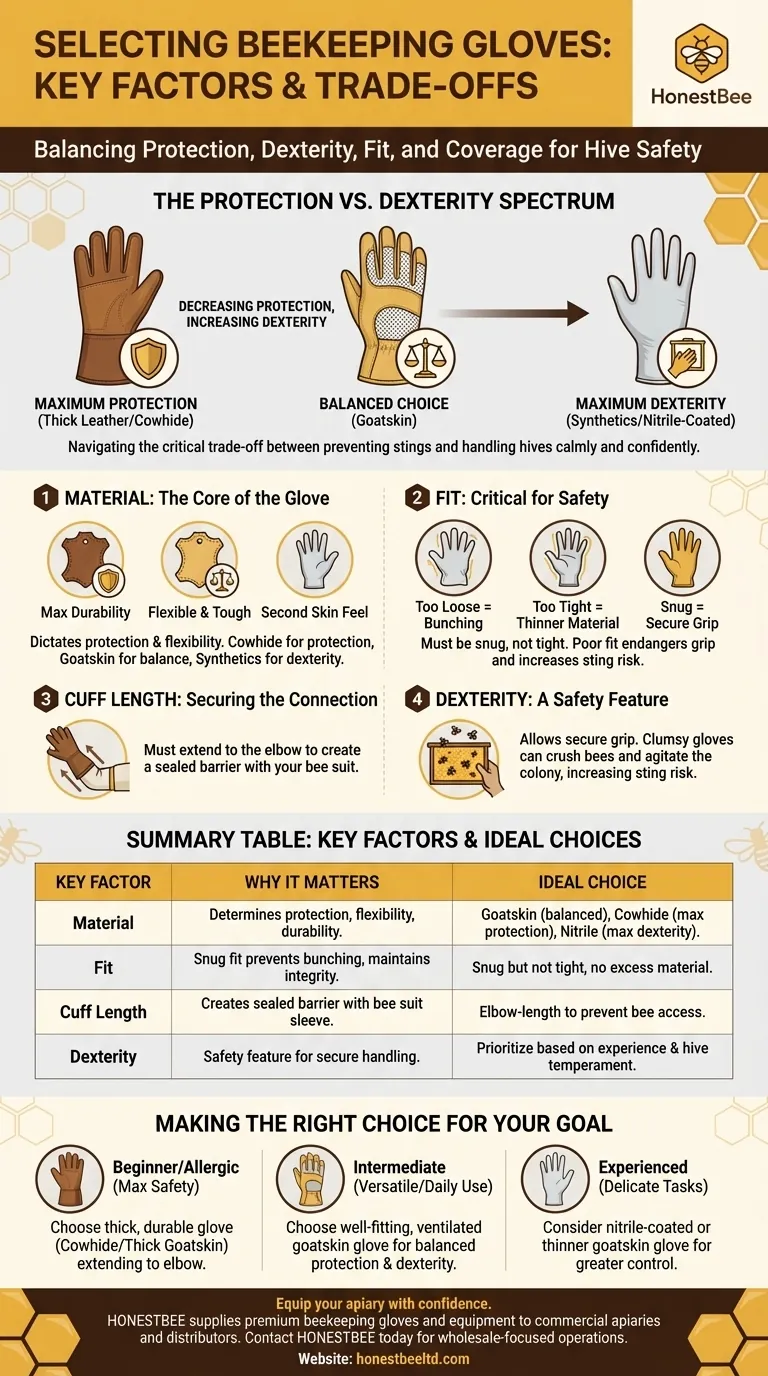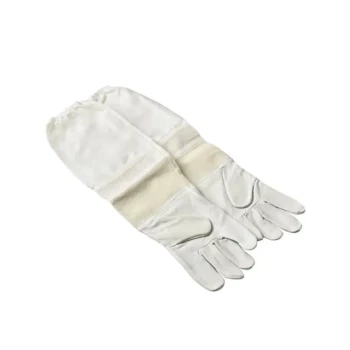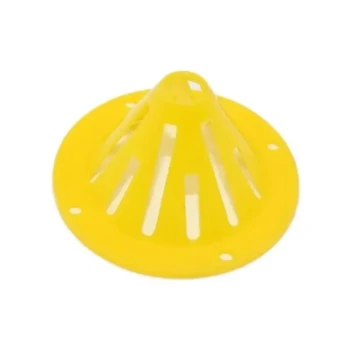When selecting beekeeping gloves, you must evaluate a specific set of factors: the material's protective qualities, the dexterity it allows, the overall fit, and the length of the cuff for arm coverage. These elements work together to determine your safety, comfort, and effectiveness when managing a hive.
The search for the perfect beekeeping glove is not about finding one that is completely sting-proof. Instead, it is about navigating the critical trade-off between maximum protection and the fine dexterity needed to work calmly and confidently with your bees.

Deconstructing Your Glove Choice
Your hands are your primary tool in beekeeping. The right gloves enhance your ability to perform inspections, while the wrong ones can be a significant liability. The choice hinges on balancing several key characteristics.
The Protection vs. Dexterity Spectrum
The most important decision you'll make is where you need to be on the spectrum between protection and dexterity.
Thick, heavy gloves offer the most protection from stings but are clumsy. This can lead you to crush bees or drop frames, which agitates the colony and increases the overall risk of being stung.
Thinner, more flexible gloves provide excellent dexterity for delicate tasks but offer less protection. Your comfort level with bees and the temperament of your specific colony will influence where you need to fall on this spectrum.
Material Analysis: The Core of the Glove
The material dictates both protection and flexibility. There are three primary categories.
-
Thick Leather (Cowhide): This is the traditional choice, offering maximum durability and sting resistance. However, it provides the least dexterity and can be very hot. It is often favored by new beekeepers who prioritize sting prevention above all else.
-
Goatskin: This material represents the most popular middle ground. It is significantly more flexible and supple than cowhide, providing good dexterity while still being tough and sting-resistant. Many premium gloves use ventilated goatskin to improve comfort.
-
Synthetics (Nitrile-Coated, Canvas): These gloves prioritize dexterity. Canvas gloves are breathable and flexible, while nitrile-coated gloves offer a "second skin" feel for maximum precision. They offer the least protection and are best suited for experienced beekeepers or very specific, delicate tasks.
The Critical Importance of Fit
A poorly fitting glove is a dangerous glove. Your glove should fit snugly, but not tightly.
If the glove is too loose, the excess material will bunch up, making it difficult to grip tools and frames securely. If it is too tight, it will stretch the material, making it thinner and easier for a bee's stinger to penetrate. A proper fit ensures both safety and functionality.
Coverage: Securing the Connection Point
Beekeeping gloves must extend well beyond the wrist, typically to the elbow. This ensures there is no exposed skin between your glove and your bee suit or jacket.
The glove's cuff is designed to be layered with your suit's sleeve, creating a sealed barrier that bees cannot crawl into.
Understanding the Trade-offs and Common Pitfalls
Choosing gloves involves more than just picking a material. You must be aware of the compromises you are making and the common mistakes to avoid.
The Myth of the "Sting-Proof" Glove
No glove is 100% sting-proof. A determined bee can, on occasion, sting through any material, especially at the seams. The goal of a good glove is to drastically reduce the frequency and success of stings, not to eliminate the possibility entirely.
The Danger of False Economy
It is tempting to opt for inexpensive, thin cotton or garden gloves. This is a critical mistake.
These materials offer almost no protection from stings. Getting stung frequently through inadequate gloves will undermine your confidence and can make you anxious and clumsy during inspections, creating a negative feedback loop.
Why Dexterity Is a Safety Feature
Losing your grip on a frame full of bees and brood is one of the worst things that can happen during an inspection. It agitates the colony immensely and can lead to a defensive reaction.
Gloves that allow for a secure, confident grip are therefore a crucial component of hive safety, even if they offer slightly less raw sting protection than a thicker, clumsier alternative.
Making the Right Choice for Your Goal
Your ideal glove depends entirely on your experience, the temperament of your bees, and your personal comfort level with risk.
- If your primary focus is maximum safety and confidence (Beginner/Allergic): Choose a thick, durable glove, likely made of cowhide or very thick goatskin, that extends to the elbow.
- If your primary focus is a versatile, all-around glove for daily use (Intermediate): Choose a well-fitting, ventilated goatskin glove that offers a good balance of protection and dexterity.
- If your primary focus is dexterity for delicate tasks (Experienced): Consider a nitrile-coated or thinner goatskin glove, accepting the trade-off of less sting protection for greater control.
The right gloves empower you to be a calmer, more confident, and ultimately more effective beekeeper.
Summary Table:
| Key Factor | Why It Matters | Ideal Choice |
|---|---|---|
| Material | Determines sting protection, flexibility, and durability. | Goatskin (balanced), Cowhide (max protection), Nitrile (max dexterity). |
| Fit | A snug fit prevents bunching and maintains material integrity. | Snug but not tight, with no excess material. |
| Cuff Length | Creates a sealed barrier with your bee suit sleeve. | Elbow-length to prevent bee access. |
| Dexterity | A safety feature for secure handling of frames and tools. | Prioritize based on experience and hive temperament. |
Equip your apiary with confidence. The right gloves are a critical investment in your safety and productivity. HONESTBEE supplies premium beekeeping gloves and equipment to commercial apiaries and distributors. Our wholesale-focused operations ensure you get durable, professional-grade gear that balances protection and dexterity for efficient hive management.
Contact HONESTBEE today to discuss your glove and equipment needs.
Visual Guide

Related Products
- Goatskin Leather Beekeeper Gloves with Vent Long Sleeve for Beekeeping Honey Bee Sting Proof Protection
- Cotton Beekeeping Suit and Round Hat with Veil Bee Keeper Protective Gear
- Mesh Ventilated 3 Layer Goatskin Beekeepers Gloves for Beekeeping
- Economy Polyester Beekeeping Jacket with Veil and Hat
- Beekeeping Jacket with Hood and Veil for Beekeepers
People Also Ask
- What should beekeepers consider regarding the fit of beekeeping gloves? Achieve Safety and Dexterity
- Why is it important to have gloves available even if not always worn? Essential Risk Management for Beekeepers
- What should be considered when selecting beekeeping gloves? Find the Perfect Fit for Safety & Dexterity
- What are the features of beekeeping gloves? Balancing Protection & Dexterity for Your Hives
- What are the characteristics of beekeeping gloves? Balancing Sting Protection with Dexterity



















